Najib J. Majaj
Spatial-frequency channels, shape bias, and adversarial robustness
Sep 22, 2023Abstract:What spatial frequency information do humans and neural networks use to recognize objects? In neuroscience, critical band masking is an established tool that can reveal the frequency-selective filters used for object recognition. Critical band masking measures the sensitivity of recognition performance to noise added at each spatial frequency. Existing critical band masking studies show that humans recognize periodic patterns (gratings) and letters by means of a spatial-frequency filter (or "channel'') that has a frequency bandwidth of one octave (doubling of frequency). Here, we introduce critical band masking as a task for network-human comparison and test 14 humans and 76 neural networks on 16-way ImageNet categorization in the presence of narrowband noise. We find that humans recognize objects in natural images using the same one-octave-wide channel that they use for letters and gratings, making it a canonical feature of human object recognition. On the other hand, the neural network channel, across various architectures and training strategies, is 2-4 times as wide as the human channel. In other words, networks are vulnerable to high and low frequency noise that does not affect human performance. Adversarial and augmented-image training are commonly used to increase network robustness and shape bias. Does this training align network and human object recognition channels? Three network channel properties (bandwidth, center frequency, peak noise sensitivity) correlate strongly with shape bias (53% variance explained) and with robustness of adversarially-trained networks (74% variance explained). Adversarial training increases robustness but expands the channel bandwidth even further away from the human bandwidth. Thus, critical band masking reveals that the network channel is more than twice as wide as the human channel, and that adversarial training only increases this difference.
SATBench: Benchmarking the speed-accuracy tradeoff in object recognition by humans and dynamic neural networks
Jun 16, 2022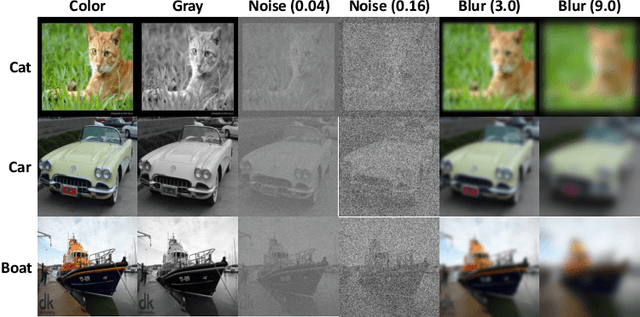

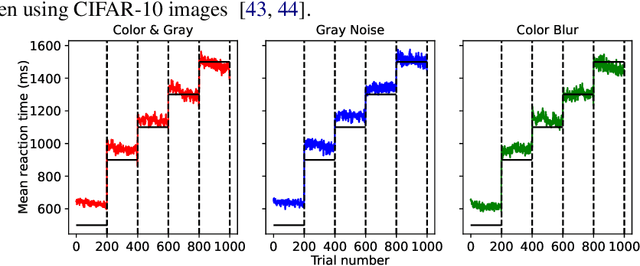

Abstract:The core of everyday tasks like reading and driving is active object recognition. Attempts to model such tasks are currently stymied by the inability to incorporate time. People show a flexible tradeoff between speed and accuracy and this tradeoff is a crucial human skill. Deep neural networks have emerged as promising candidates for predicting peak human object recognition performance and neural activity. However, modeling the temporal dimension i.e., the speed-accuracy tradeoff (SAT), is essential for them to serve as useful computational models for how humans recognize objects. To this end, we here present the first large-scale (148 observers, 4 neural networks, 8 tasks) dataset of the speed-accuracy tradeoff (SAT) in recognizing ImageNet images. In each human trial, a beep, indicating the desired reaction time, sounds at a fixed delay after the image is presented, and observer's response counts only if it occurs near the time of the beep. In a series of blocks, we test many beep latencies, i.e., reaction times. We observe that human accuracy increases with reaction time and proceed to compare its characteristics with the behavior of several dynamic neural networks that are capable of inference-time adaptive computation. Using FLOPs as an analog for reaction time, we compare networks with humans on curve-fit error, category-wise correlation, and curve steepness, and conclude that cascaded dynamic neural networks are a promising model of human reaction time in object recognition tasks.
Using Human Psychophysics to Evaluate Generalization in Scene Text Recognition Models
Jun 30, 2020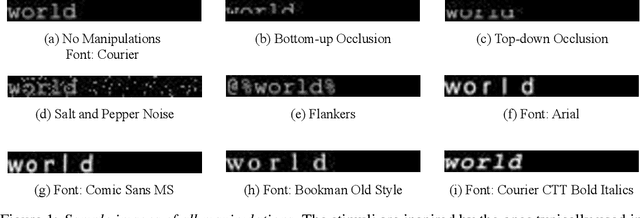
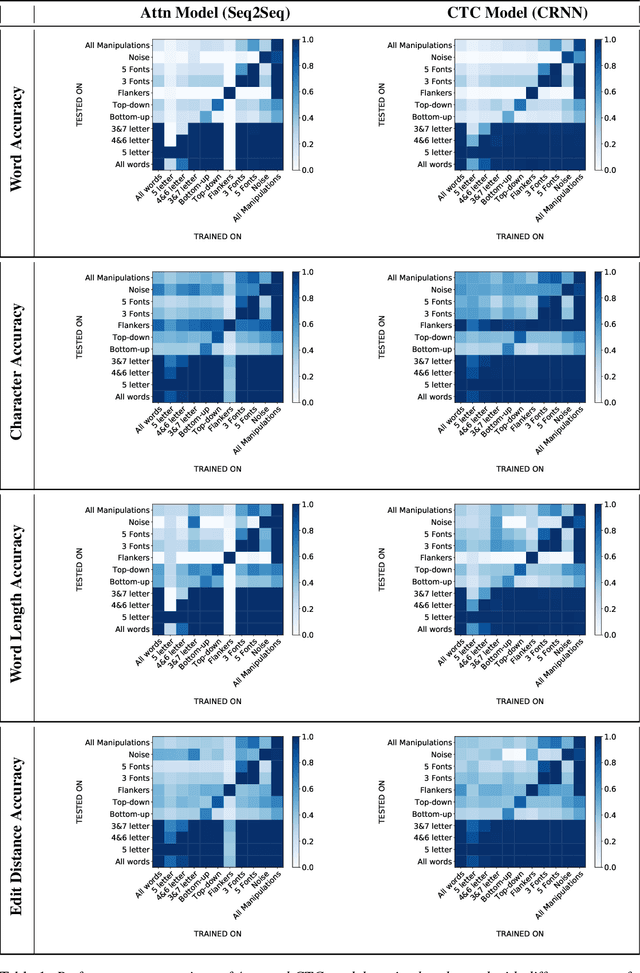
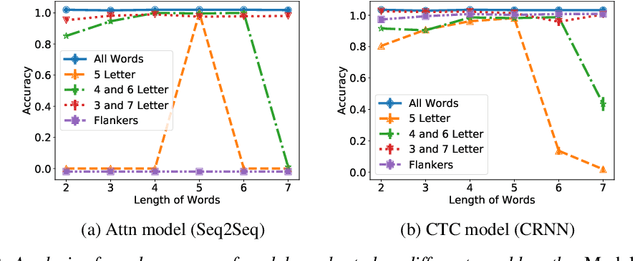
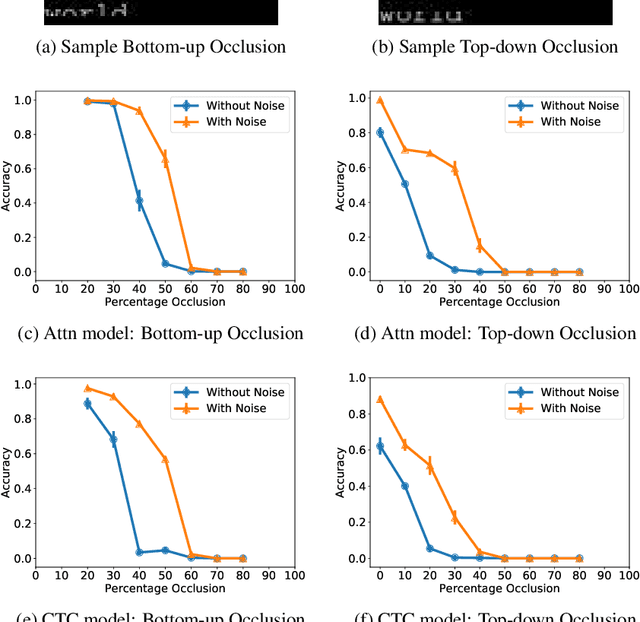
Abstract:Scene text recognition models have advanced greatly in recent years. Inspired by human reading we characterize two important scene text recognition models by measuring their domains i.e. the range of stimulus images that they can read. The domain specifies the ability of readers to generalize to different word lengths, fonts, and amounts of occlusion. These metrics identify strengths and weaknesses of existing models. Relative to the attention-based (Attn) model, we discover that the connectionist temporal classification (CTC) model is more robust to noise and occlusion, and better at generalizing to different word lengths. Further, we show that in both models, adding noise to training images yields better generalization to occlusion. These results demonstrate the value of testing models till they break, complementing the traditional data science focus on optimizing performance.
Brain-Like Object Recognition with High-Performing Shallow Recurrent ANNs
Oct 28, 2019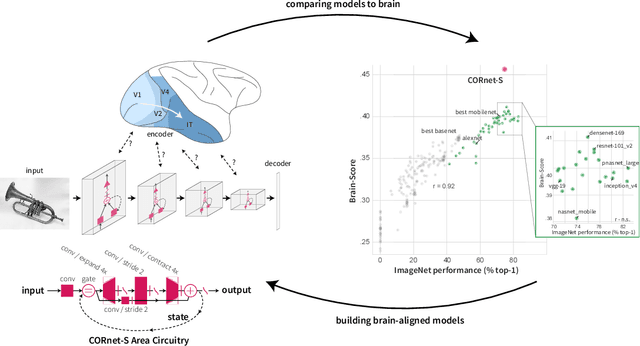
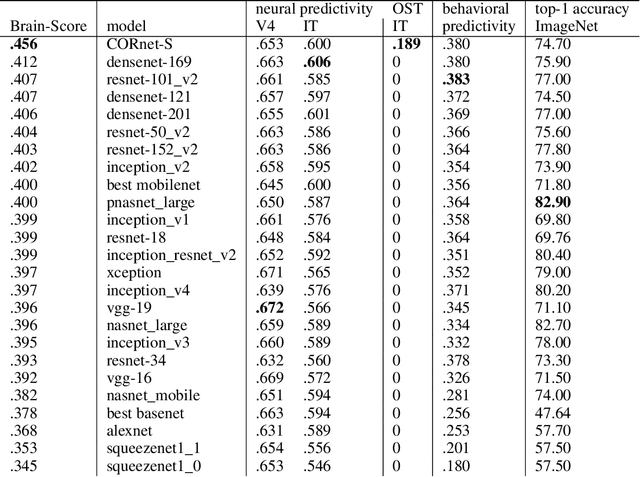

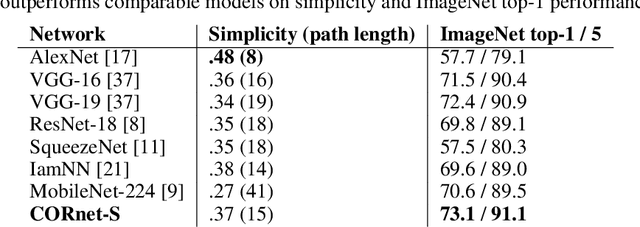
Abstract:Deep convolutional artificial neural networks (ANNs) are the leading class of candidate models of the mechanisms of visual processing in the primate ventral stream. While initially inspired by brain anatomy, over the past years, these ANNs have evolved from a simple eight-layer architecture in AlexNet to extremely deep and branching architectures, demonstrating increasingly better object categorization performance, yet bringing into question how brain-like they still are. In particular, typical deep models from the machine learning community are often hard to map onto the brain's anatomy due to their vast number of layers and missing biologically-important connections, such as recurrence. Here we demonstrate that better anatomical alignment to the brain and high performance on machine learning as well as neuroscience measures do not have to be in contradiction. We developed CORnet-S, a shallow ANN with four anatomically mapped areas and recurrent connectivity, guided by Brain-Score, a new large-scale composite of neural and behavioral benchmarks for quantifying the functional fidelity of models of the primate ventral visual stream. Despite being significantly shallower than most models, CORnet-S is the top model on Brain-Score and outperforms similarly compact models on ImageNet. Moreover, our extensive analyses of CORnet-S circuitry variants reveal that recurrence is the main predictive factor of both Brain-Score and ImageNet top-1 performance. Finally, we report that the temporal evolution of the CORnet-S "IT" neural population resembles the actual monkey IT population dynamics. Taken together, these results establish CORnet-S, a compact, recurrent ANN, as the current best model of the primate ventral visual stream.
Deep Neural Networks Rival the Representation of Primate IT Cortex for Core Visual Object Recognition
Jun 12, 2014
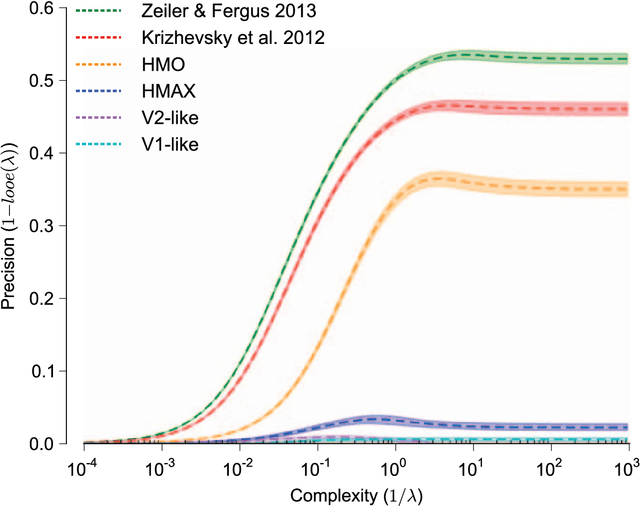
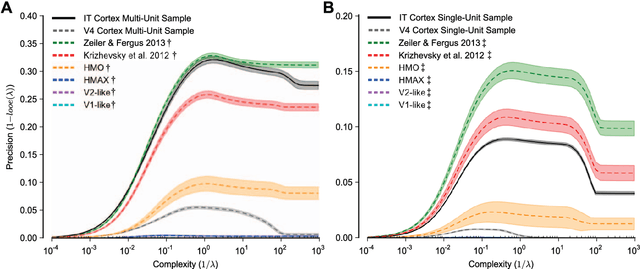
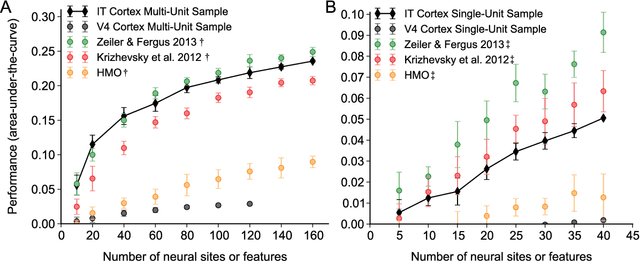
Abstract:The primate visual system achieves remarkable visual object recognition performance even in brief presentations and under changes to object exemplar, geometric transformations, and background variation (a.k.a. core visual object recognition). This remarkable performance is mediated by the representation formed in inferior temporal (IT) cortex. In parallel, recent advances in machine learning have led to ever higher performing models of object recognition using artificial deep neural networks (DNNs). It remains unclear, however, whether the representational performance of DNNs rivals that of the brain. To accurately produce such a comparison, a major difficulty has been a unifying metric that accounts for experimental limitations such as the amount of noise, the number of neural recording sites, and the number trials, and computational limitations such as the complexity of the decoding classifier and the number of classifier training examples. In this work we perform a direct comparison that corrects for these experimental limitations and computational considerations. As part of our methodology, we propose an extension of "kernel analysis" that measures the generalization accuracy as a function of representational complexity. Our evaluations show that, unlike previous bio-inspired models, the latest DNNs rival the representational performance of IT cortex on this visual object recognition task. Furthermore, we show that models that perform well on measures of representational performance also perform well on measures of representational similarity to IT and on measures of predicting individual IT multi-unit responses. Whether these DNNs rely on computational mechanisms similar to the primate visual system is yet to be determined, but, unlike all previous bio-inspired models, that possibility cannot be ruled out merely on representational performance grounds.
The Neural Representation Benchmark and its Evaluation on Brain and Machine
Jan 25, 2013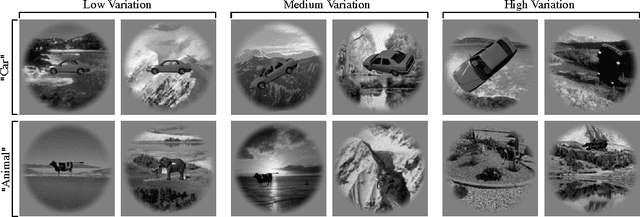

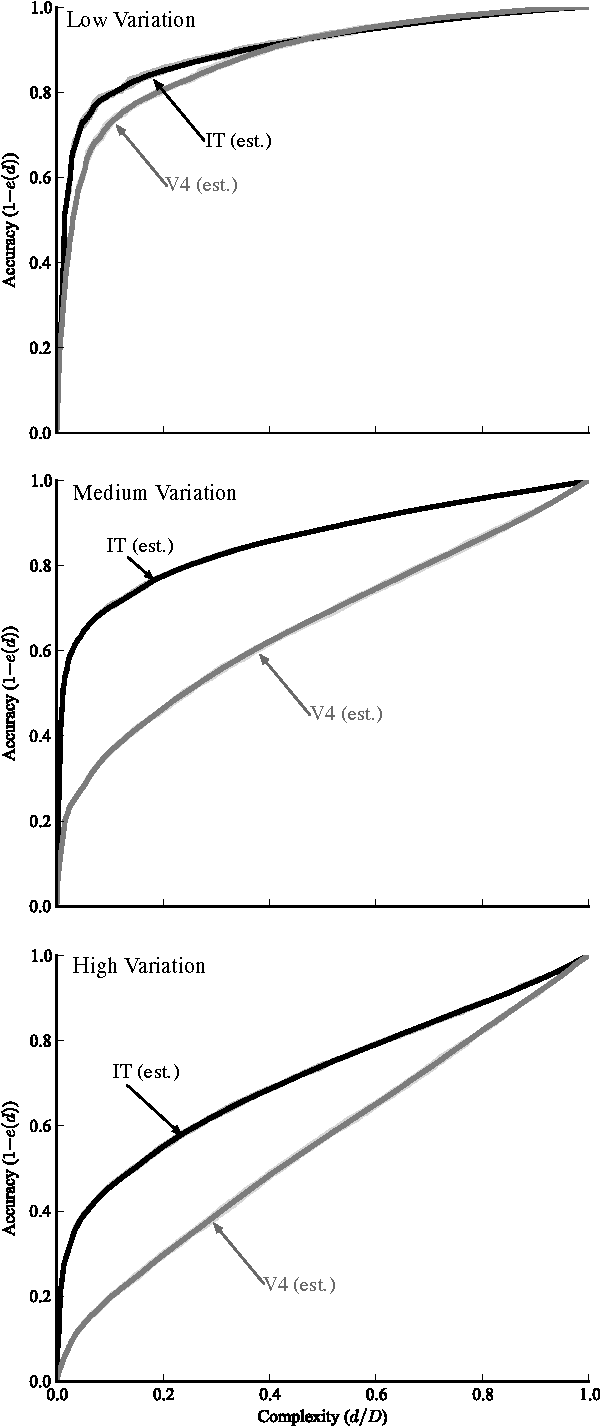
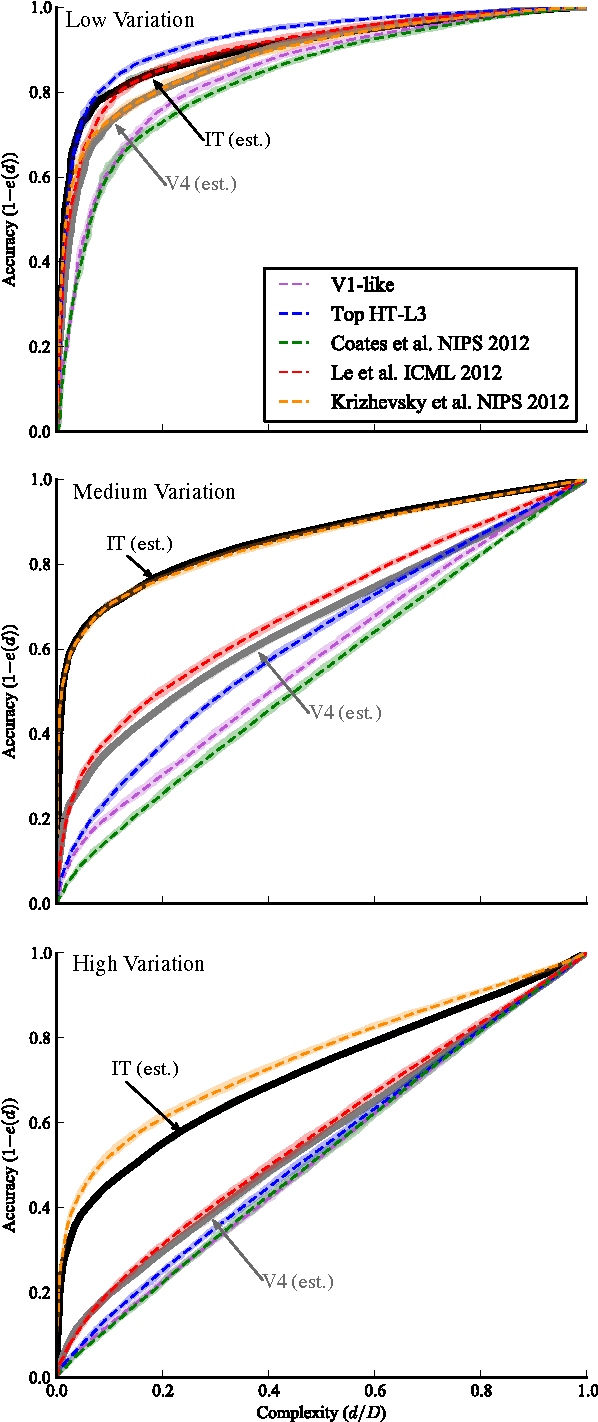
Abstract:A key requirement for the development of effective learning representations is their evaluation and comparison to representations we know to be effective. In natural sensory domains, the community has viewed the brain as a source of inspiration and as an implicit benchmark for success. However, it has not been possible to directly test representational learning algorithms directly against the representations contained in neural systems. Here, we propose a new benchmark for visual representations on which we have directly tested the neural representation in multiple visual cortical areas in macaque (utilizing data from [Majaj et al., 2012]), and on which any computer vision algorithm that produces a feature space can be tested. The benchmark measures the effectiveness of the neural or machine representation by computing the classification loss on the ordered eigendecomposition of a kernel matrix [Montavon et al., 2011]. In our analysis we find that the neural representation in visual area IT is superior to visual area V4. In our analysis of representational learning algorithms, we find that three-layer models approach the representational performance of V4 and the algorithm in [Le et al., 2012] surpasses the performance of V4. Impressively, we find that a recent supervised algorithm [Krizhevsky et al., 2012] achieves performance comparable to that of IT for an intermediate level of image variation difficulty, and surpasses IT at a higher difficulty level. We believe this result represents a major milestone: it is the first learning algorithm we have found that exceeds our current estimate of IT representation performance. We hope that this benchmark will assist the community in matching the representational performance of visual cortex and will serve as an initial rallying point for further correspondence between representations derived in brains and machines.
 Add to Chrome
Add to Chrome Add to Firefox
Add to Firefox Add to Edge
Add to Edge